Even weirder than Spock’s Brain. In the best way.
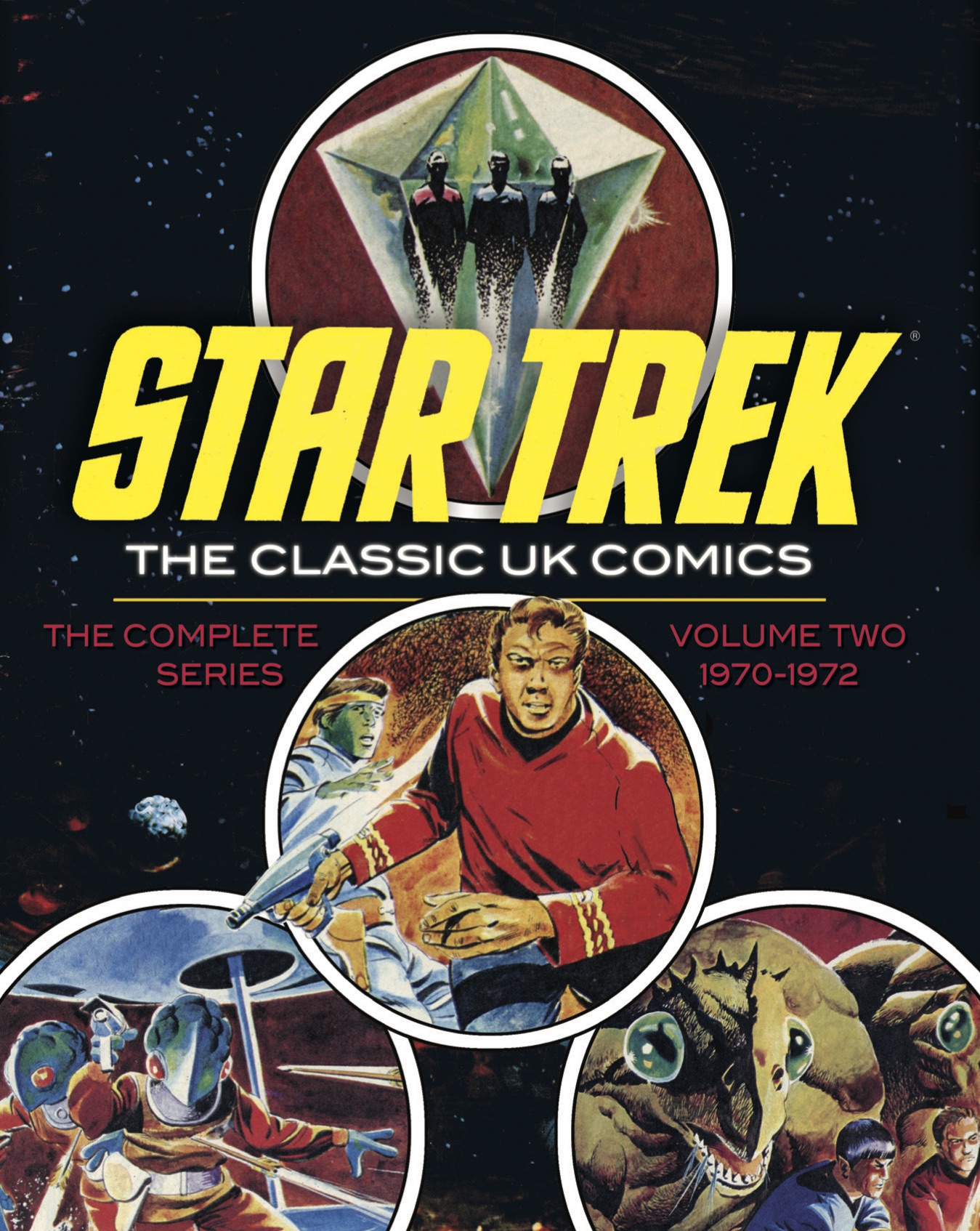
—
By RICH HANDLEY
IDW Publishing’s Library of American Comics imprint has released the second volume of its Star Trek: The Classic UK Comics reprint collection. (Click here for a SNEAK PEEK.) The three-book hardcover set is making available all of the long-forgotten Star Trek comic strips published from 1969 to 1973 in the pages of various weekly British comic-strip magazines and children’s annuals.*
Fans who remember these lost tales will be amazed at how well they’ve been cleaned up compared to their initial presentation on faded newspaper print. Those new to the strips might wonder if they’ve suddenly overdosed on cordrazine.
These serialized weekly strips were published concurrent with the early years of Gold Key’s Star Trek comic line. Prior to IDW’s efforts, they’ve never been reproduced aside from a few pages reprinted decades ago in fanzines.
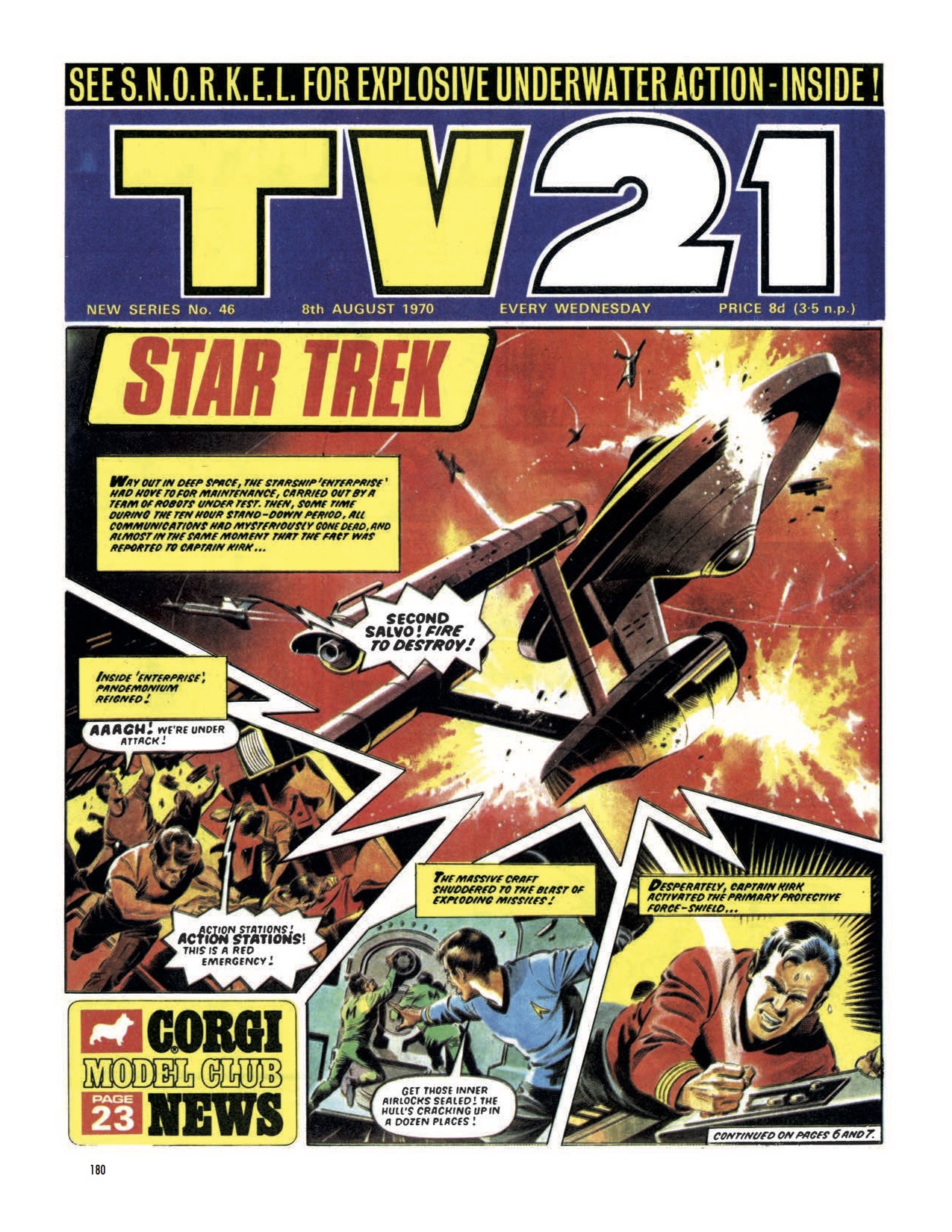
From Vol. 1
Those unfamiliar with the strips might be put off at first, as they are remarkably different than the 1960s television series. These were produced during the earliest days of Star Trek, when the TV series’ UK premiere was still six months off. As such, the writers and artists were largely in the dark about the show’s characters, dialogue, themes and visual aesthetics. The results were often hilariously off the mark.
This doesn’t mean readers will not enjoy reading them. On the contrary, they’re wonderful fun—it’s their “offness” that makes them so readable. They’re unique in the annals of Star Trek, surpassing even Gold Key in their sheer weirdness, and they deserve the proper reprinting they’re finally receiving. But they are undeniably weird. How so?
Here are 13 Bizarre Differences Between Star Trek and Its Wacky UK Comics:
The crew yelled out all their lines! Everyone aboard the Enterprise must have been super-excited at all times! They were always yelling! Every time they spoke, they did so with exclamation marks! Every! Single! Line! Had! An! Exclamation! Mark! At! The! End! Plus, they sure liked to express their exasperation in space-y terms! “Great Jupiter!” “Bursting novas!” “Thundering spacejets!” “Streaking comets!” “Sufferin’ starships!” There was never any doubt they worked in outer space! It could have been worse, though! Had Star Trek been a series about accountants, they would have yelled things like “Fixed assets!” “Balanced sheets!” and “By the general ledger!”
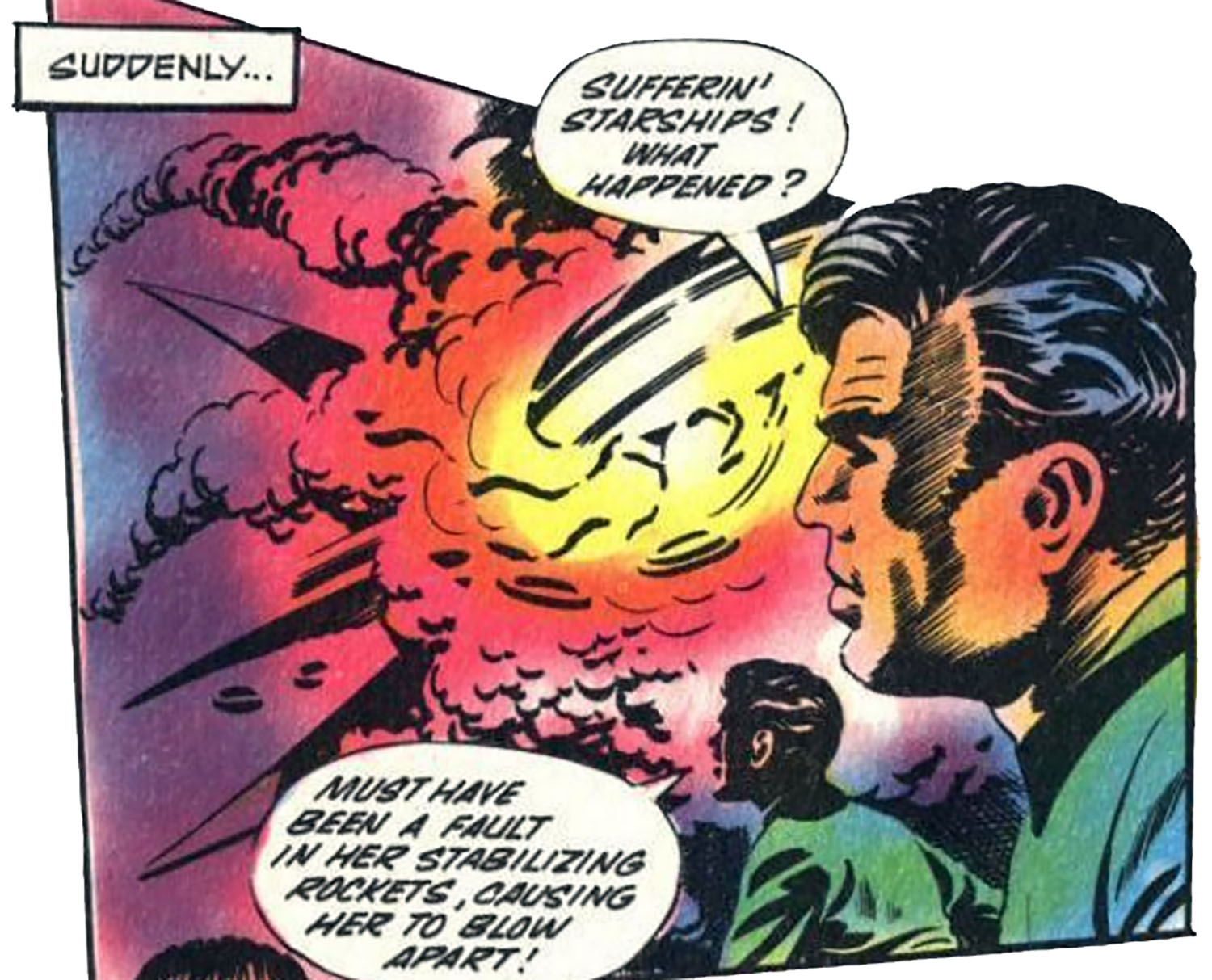
—
Kirk surrendered to alien invaders at the drop of a hat. The comic strips’ version of James Kirk was apparently all bark and no bite. Although he rushed into situations headlong, phaser at the ready and more than willing to kill, he was also quick to surrender if his opposition put up any kind of fight. Robots commandeering the Enterprise? Surrender. An alien vessel opening fire? Surrender. A robe-wearing politician threatening Kirk with a knife? Surrender. A crippled child armed with a broken slingshot demanding that Kirk hand over the keys to the Enterprise, Earth, and the entire Space Federation? Surrender.
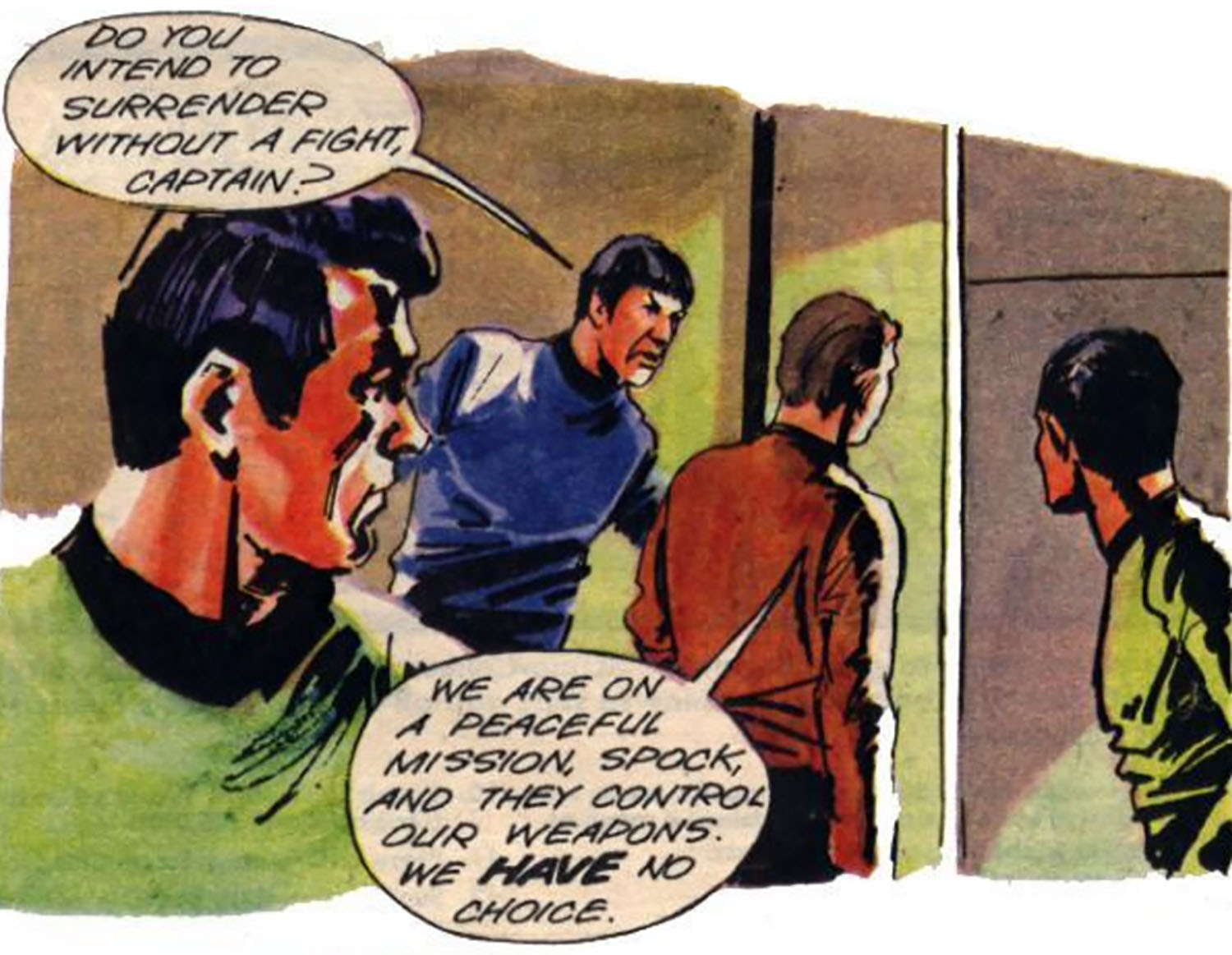
—
No one seemed aware of the Prime Directive. As noted, Kirk tended to rush into any conflict with guns blazing, and Spock frequently shared his thirst for blood. He also exhibited a marked lack of tolerance for differing opinions. If an alien culture were doing something that offended his Space Federation sensibilities, its leaders were unquestionably wrong and needed to be taught an Earth lesson. At no point would anyone in the crew point out that actions such as involving the Enterprise crew in local conflicts, altering the course of a culture’s natural evolution, or outright invading a planet would blatantly violate General Order One—primarily because it’s doubtful the writers had any idea it existed.
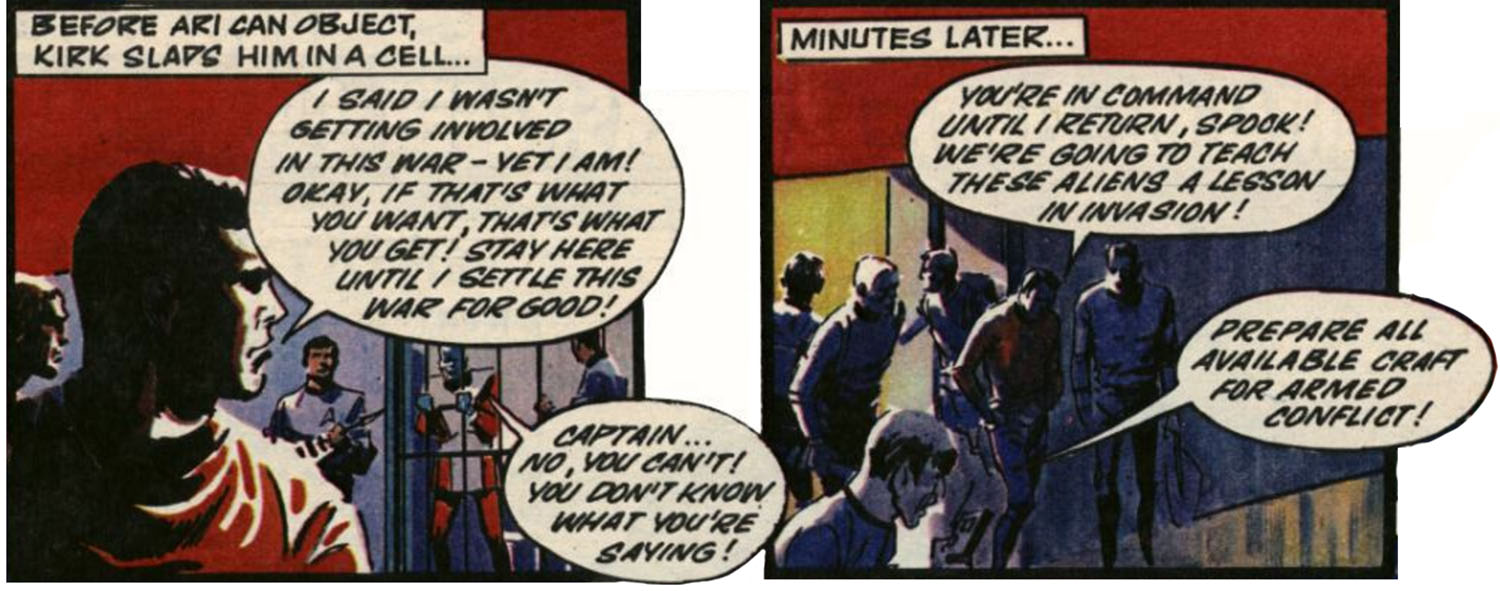
—
Kirk was sometimes a Redshirt. In early strips, Kirk wore a yellowish-orange outfit, somewhat close to the color of his onscreen tunic. Later on, he began wearing a red uniform, likely due to a change in colorist. This may explain why he so often surrendered—Kirk realized his red outfit made him much more likely to die during a dangerous mission. Then again, security guards tended to sport blue uniform shirts instead of red, while others, including David Bailey (from The Corbomite Maneuver, who was, oddly, a regular character in the strips) and Sulu wore green. It could be that Kirk was mixing up tunic colors to confuse enemies and thus reduce the likelihood of crew deaths.
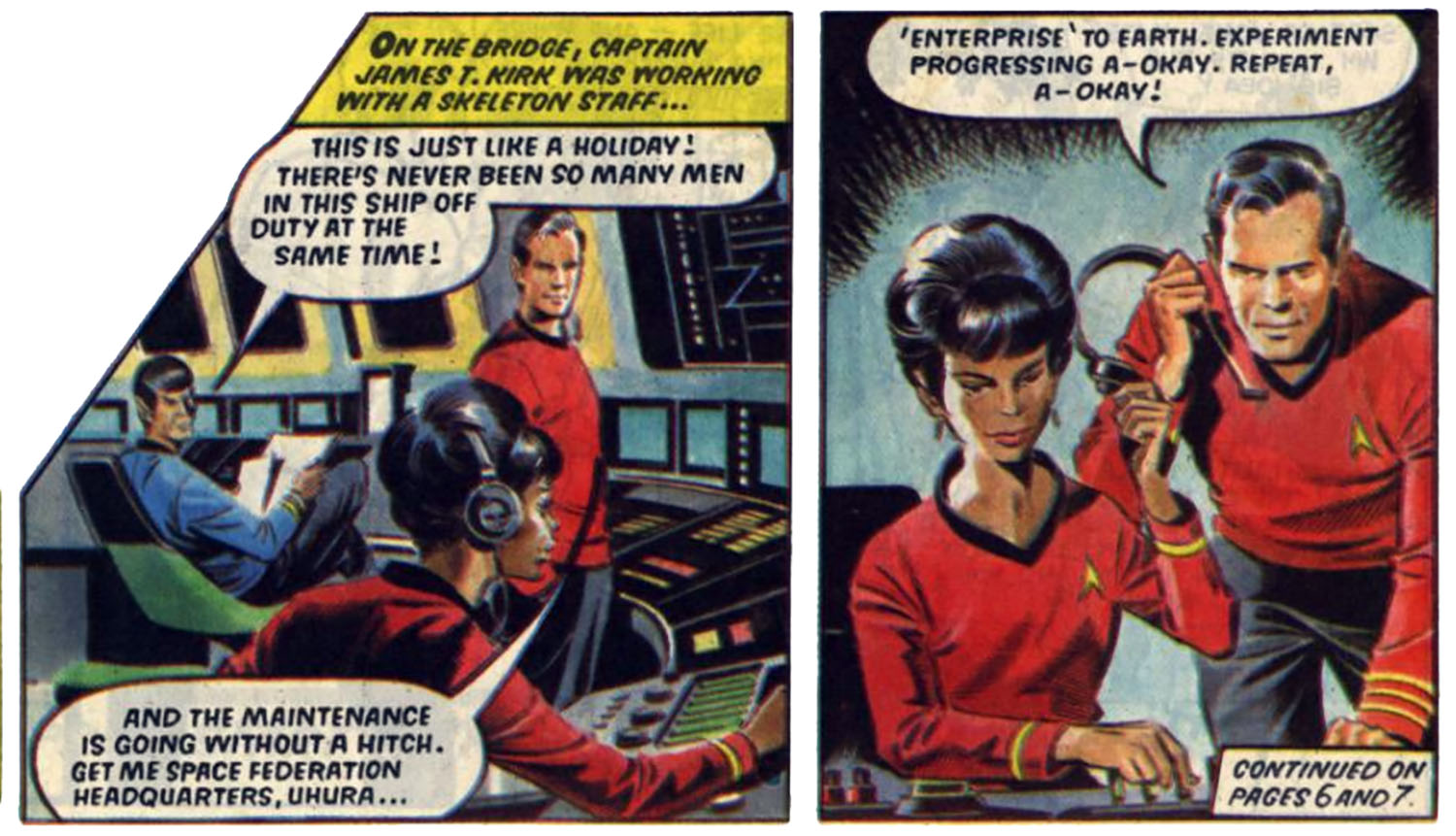
—
The terminology and technology were vastly different. Given the writers’ unfamiliarity with the TV show, not to mention their having been from the United Kingdom, it was pretty standard for the strips to employ the wrong names for weapons, gadgets and pretty much everything else. Earth was part of the Space Federation. The starship was called the Universe Space Ship Enterprise. Its bridge was called the command centre (note the British spelling) and the control sector. Transporters were teleportation units. And so forth. Moreover, references to battle terminology, navigation, and weaponry made the Enterprise seem more like a World War II submarine than a futuristic starship.
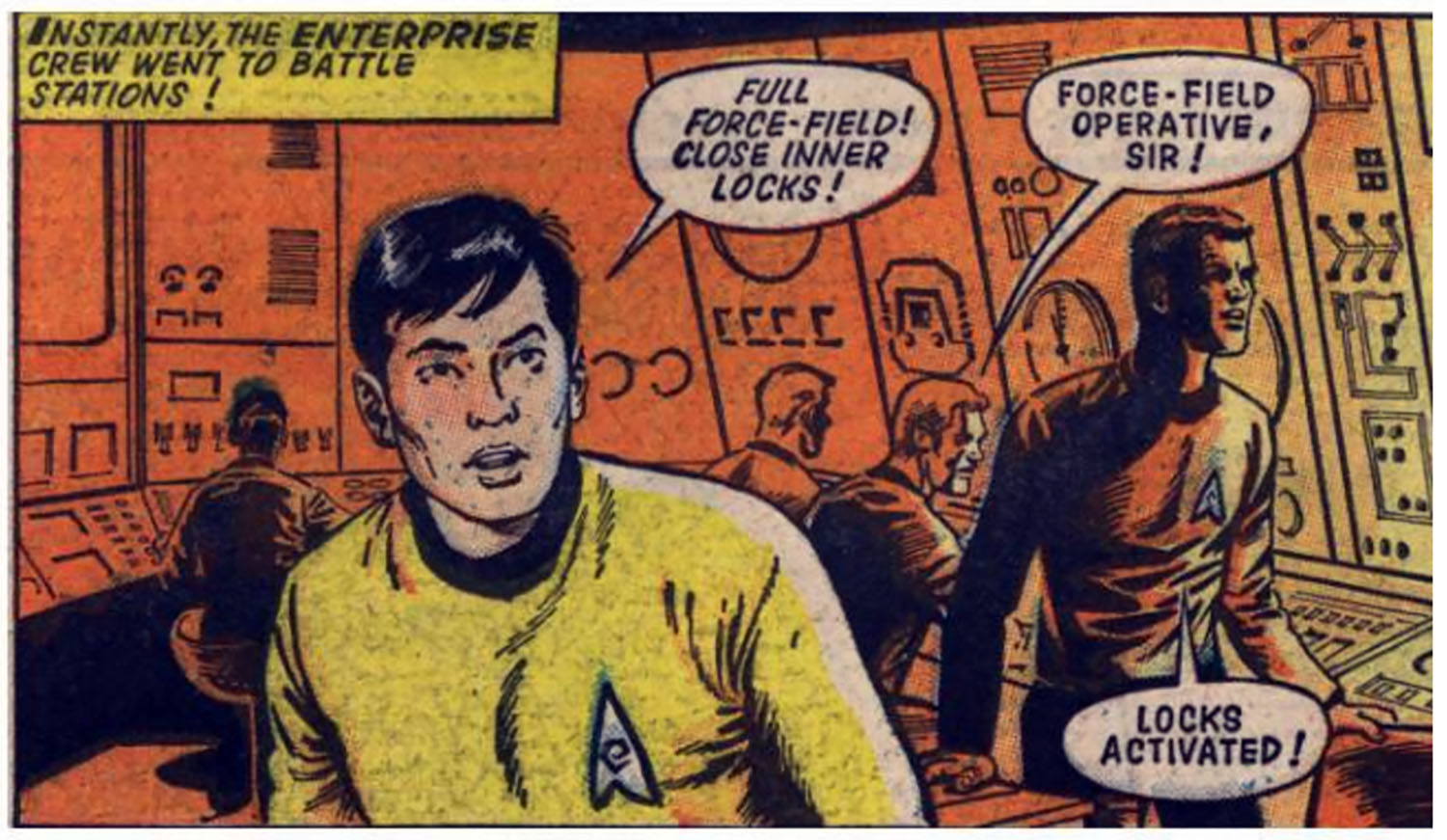
—
The Romulans sported beards and rounded ears, and dressed like ancient Romans. The televised Romulans were based on the Roman Empire, of course, as evidenced by their names and military titles (centurion, for instance). But they weren’t actual Romans—they were aliens, and the Vulcans’ long-lost cousins. The strips’ creators apparently didn’t realize this, as the Romulans had human facial features, dressed like they’d just wandered in from the set of Ben-Hur, and forced captured enemies to fight in an arena.
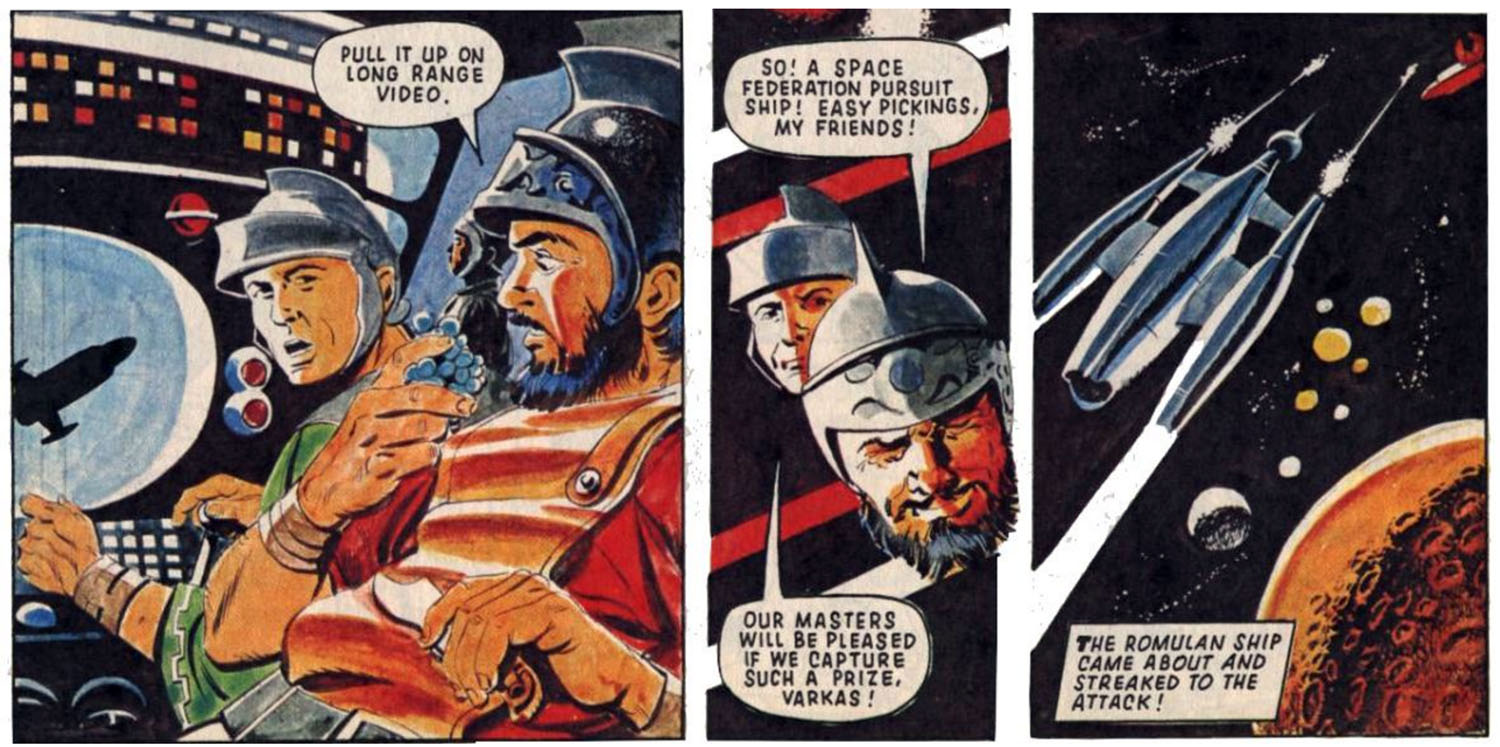
—
Klingon plots were often devised by evil scientists. On television, the Klingon Empire was a martial culture in which control was maintained via military might. In the strips, the (purple) Klingons—who tended to be drawn with receding hairlines and oversized foreheads, prophetically mirroring their more modern-day appearance, sans cranial ridges—frequently used science to defeat their archenemies. Typical dastardly Klingon plots included transferring a person’s mind into another individual’s body, creating vapor clouds to assassinate political delegates, and hypnotizing starship personnel to do their bidding.

—
Names, nicknames, and species were incorrectly identified from time to time. Thankfully, this didn’t happen often—but when it did, it was great for a laugh. In the very first installment and a few others thereafter, James Kirk was called “Captain Kurt,” while later strips misspelled Uhura’s surname as “Uhuru” and identified Spock as a “Vulcanite.” What’s more, many stories saw the crew calling McCoy “Mac” instead of “Bones.”
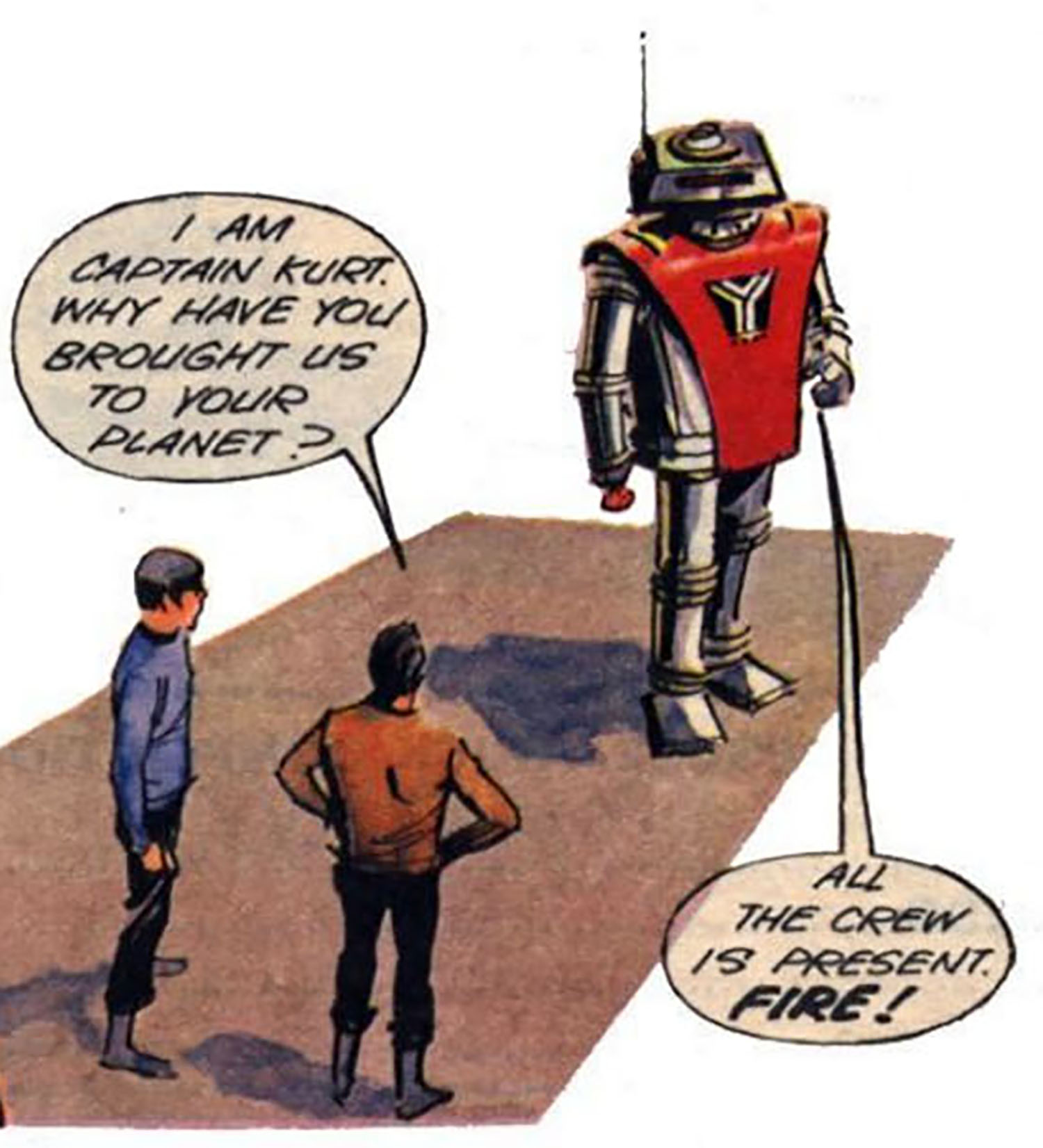
—
The Enterprise’s shuttlecrafts looked like they’d been borrowed from other franchises. On the TV series, the USS Enterprise contained a number of smaller, simply designed vessels used for planetary missions, including the Galileo. In the early strips, however, the starship housed a large fleet of multi-colored vehicles—space bugs, repair wagons, exploration rockets, pursuit ships, rescue capsules, etc.—that seemed to have been cribbed from Gerry Anderson’s TV shows and pulp magazines like Amazing Stories and Astounding Science Fiction. Later tales featured a never-ending armada of same-named (and quickly destroyed) Galileos.
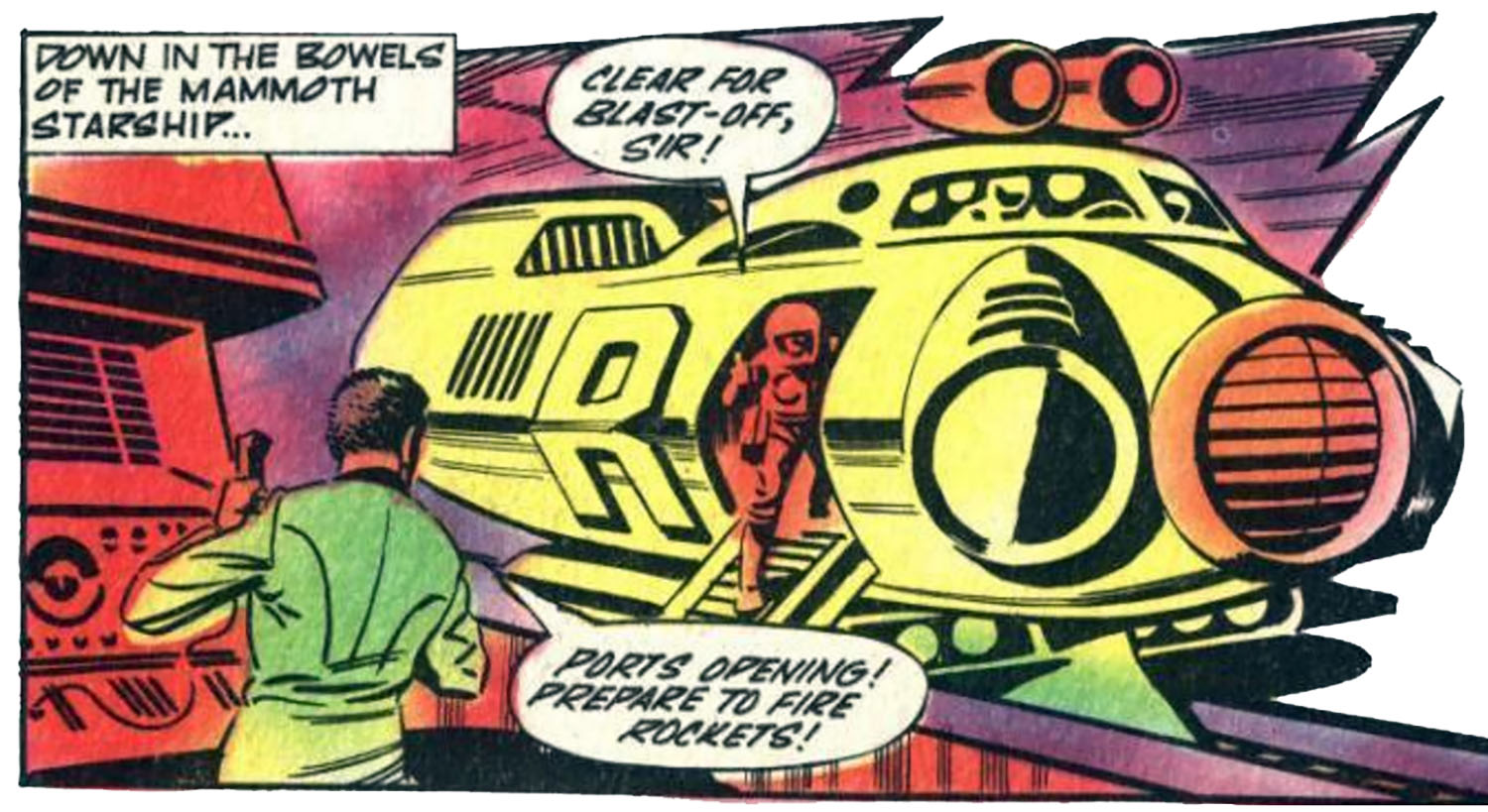
—
The Enterprise was nuclear-powered and had a crew of thousands. The Enterprise on television utilized clean matter-antimatter engines and required dilithium to control a warp drive system’s power. Not so in the strips: this sucker was radioactive, with glowing nuclear energy rods stored in a central power complex. The engines were so dangerous to be around that personnel had to wear special protective suits when opening the starship’s cobalt containers. Additionally, the show’s 430-member crew ballooned to several times that number in the strips.

—
The Enterprise routinely visited other galaxies. The Enterprise’s U.S. adventures were always limited to within the Milky Way, unless under unusual circumstances (such as the Kelvans modifying the ship’s engines to allow extragalactic travel), since our galaxy was surrounded by an energy barrier that messed with navigational systems, caused extreme sensory distortions, and increased psychic abilities. The British crew, however, visited new galaxies on a regular basis—galaxies with such imaginative names as Galaxy T-21, Galaxy 517, Galaxy M-674, the Gamma Galaxy, and the Omega Galaxy.
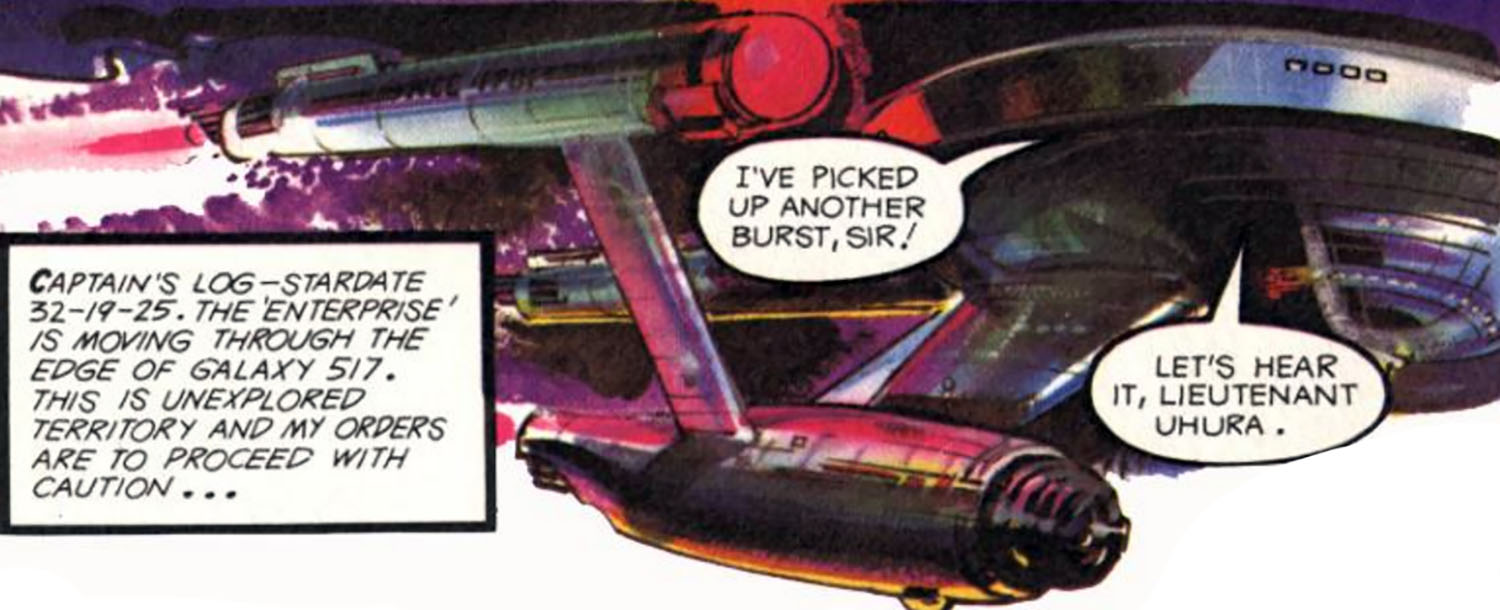
—
The crew often battled giant creatures. The Enterprise crew was no stranger to giants on TV, as they met the Greek god Apollo, faced the witch Sylvia in giant-cat form, and even encountered a humongous Spock in the animated series. But in the strips, giants seemed to be everywhere—and they looked just like Earth creatures both real and mythical: eagles, snails, ants, spiders, lizards, mantises, flying reptiles, even cyclopses. In one story, clearly riffing on Land of the Giants, the crew faced off against… a giant humanoid housewife named Gorda, who nearly vacuumed them to death.
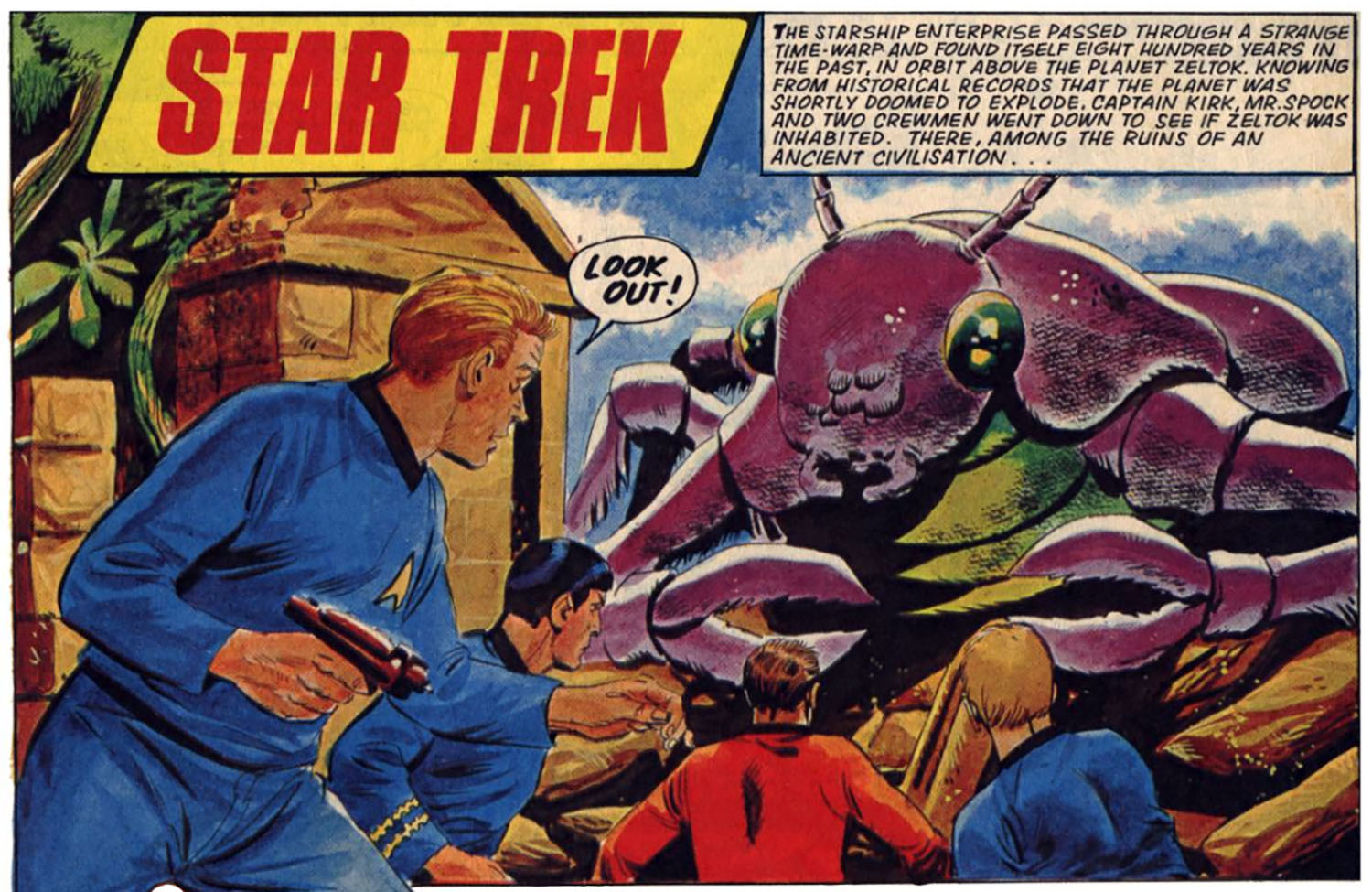
—
Everyone called Kirk “Skipper.” Don’t be confused as you begin reading the British Star Trek strips and notice that everyone aboard the Enterprise addresses Kirk as “Skipper.” You haven’t inadvertently picked up a collection of Gilligan’s Island comics. It’s simply a British thing. Although “skipper” is also a common nickname for the master of a vessel in the United States, Kirk’s crew always called him “captain” onscreen, or “Jim” if they were close.
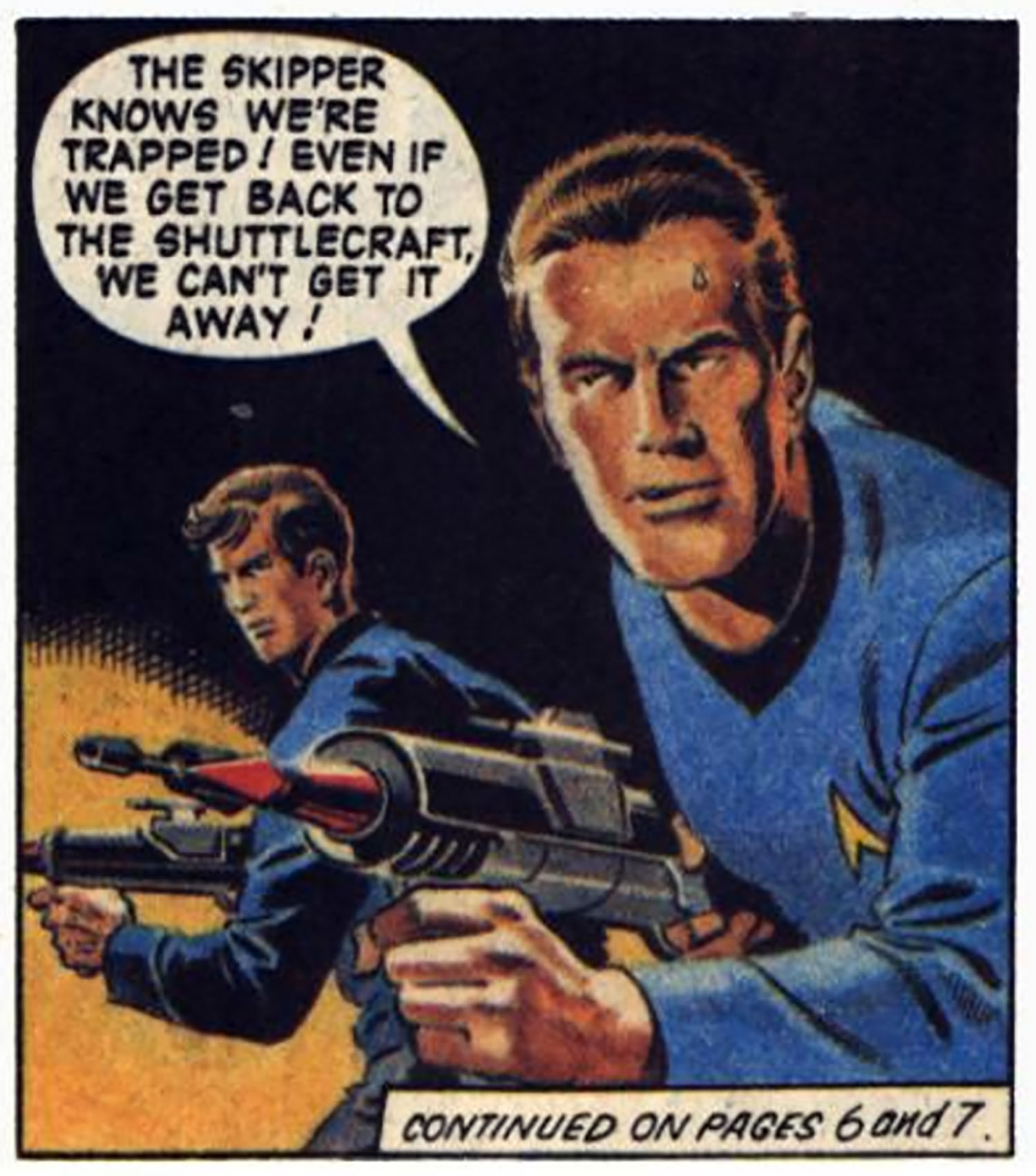
—
Star Trek has long been praised for its lofty ideals, its optimistic vision of the future, and its inspiring messages of hope, peace and infinite diversity. Sadly, you’ll find very little of that in the British comic strips. But it’s important to remember that these stories represent a different era. They’re lost gems with many facets and a unique perspective, an eccentric corner of Trek history that fans need to experience.
—
Rich Handley is the editor of Hasslein Books. His work includes Planet of the Apes: Tales from the Forbidden Zone (Titan Books), Watching Time: The Watchmen Chronology, Timeline of the Planet of the Apes, Lexicon of the Planet of the Apes, Back in Time: The Back to the Future Chronology, A Matter of Time: The Back to the Future Lexicon, and five essay anthologies for Sequart about Planet of the Apes and Star Wars. Rich has contributed to IDW’s five Star Trek comic strip reprint books, Sequart’s New Life and New Civilizations: Exploring Star Trek Comics and The Cyberpunk Nexus: Exploring the Blade Runner Universe, and ATB Publishing’s Outside In Boldly Goes. A former reporter for Star Trek Communicator, he has written numerous works for Lucasfilm’s licensed Star Wars universe and contributed to many magazines and websites, including 13th Dimension.
—
*Here’s the rundown by hardcover volume:
Vol. 1 reprinted storylines #1-17 (from Joe 90: Top Secret issues #1-34, TV21 and Joe 90 #1-38, and TV21 #39-64), as well as the 1969 Joe 90: Top Secret Annual.
Vol. 2 features storylines #18-30 (from TV21 issues #65-105 and Valiant and TV21 issues #1-42), plus a supplemental story presented in the 1971 TV21 Annual.
Vol. 3, coming later this year, will complete the run with storylines #31-37 (from Valiant issues #43-118), along with the 1972 Valiant Summer Special, the 1972 and 1973 TV21 Annuals, the 1978 Mighty TV Comic Annual, the 1979 TV Comic Annual and other goodies.
Each volume will also include supplementary materials (full disclosure: written by yours truly).
